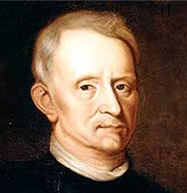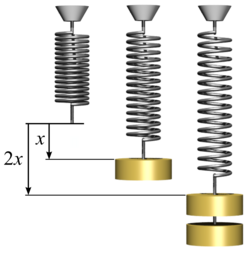Robert Hooke
The life and work of Robert Hooke Page claimed by Chris Bauer (cbauer8) on 11/11/2015

.
Personal Life
Robert Hooke was born July 18, 1635 in Freshwater, England. Growing up Hooke fell sick very often, and during these times he found his love to paint and build mechanisms. His parents died when he was very young so he moved to London and wend to the Westminster school and later to Oxford University. He worked as an assistant to Robert Boyle, and this helped him learn about a wide range of subjects from Chemistry to Astronomy. He did research in London discovering several influential topics until he died March 3, 1703 at the age of 67. He never married.
Scientific Contributions
Hooke's Law
In 1678 Hooke published a book titled "Lecture's of Springs." The main topic of this book was elasticity and how it can be modeled. Elasticity is the property of an object or material which causes it to be restored to its original shape after distortion. Springs are elastic because they are restored very closely to the original. An inelastic object would be one that doesn't restore to the original well like plastic being broken. Hooke's law states that the restoring force is proportional to the stretch. This can be defined by the equation F=-kx where k is the spring constant and x is the distance the spring is stretched. This means that to stretch a spring twice as far, the force must be twice as large. This law only applies for ideal situations. If the force is to large, the string will snap.

Micrographia- the Discovery of the Cell
Robert Hooke used the best tools available while he was doing research. During this time Hooke was using a simple compound microscope. Under it he looked at a vast array of items such as insects, snow, razors, cork, etc. He would then draw what he saw and put it in his book "Micrographia." He could see in vivid detail the hairs on the insects and when looking at the cork he noticed that it had sections he called "cells." The microscope didn't change for over 200 years which kept his book relevant. Also in his book were his ideas about Philosophy, the Universe, and the origin of fossils. He described light as a wave which was eventually incorporated into particle and quantum physics. Other than these theoretical contributions he also created a pocket watch which used a spring balance, the first of its kind. This book was influential in the everyday adoption of the microscope.
Other
Fun Facts
Even with all of his contributions to Science, Hooke was often overlooked at the time. This is due to the vast amount of ideas he came up with and because of his fights with other scientists. For example when he showed to the public his watch which used springs to keep extremely accurate time another scientist was also claiming that he came up with this idea. After he died credit was given to Hooke when scholars saw his handwritten notes of a watch years before the other scientist. He also had a major rivalry with Sir Isaac Newton. Newton is credited with discovering gravitation, but Hooke said not so fast. Many years earlier he described that in fact the Sun and Earth were attracted to one another and that as they got closer this attraction increased. Newton proved this idea with advanced Mathematics which Hooke was not capable of doing. One of Newton's most famous quotes is "If I have seen further it is by standing on the shoulder's of giants," and though he never said it he was referring to Hooke.
See also
Further reading
http://www.biography.com/people/robert-hooke-9343172#synopsis http://www.history-of-the-microscope.org/robert-hooke-microscope-history-micrographia.php
External links
References
http://www.biography.com/people/robert-hooke-9343172#synopsis http://io9.com/5877660/was-robert-hooke-really-sciences-greatest-asshole http://www.history-of-the-microscope.org/images/Robert-Hooke.jpg